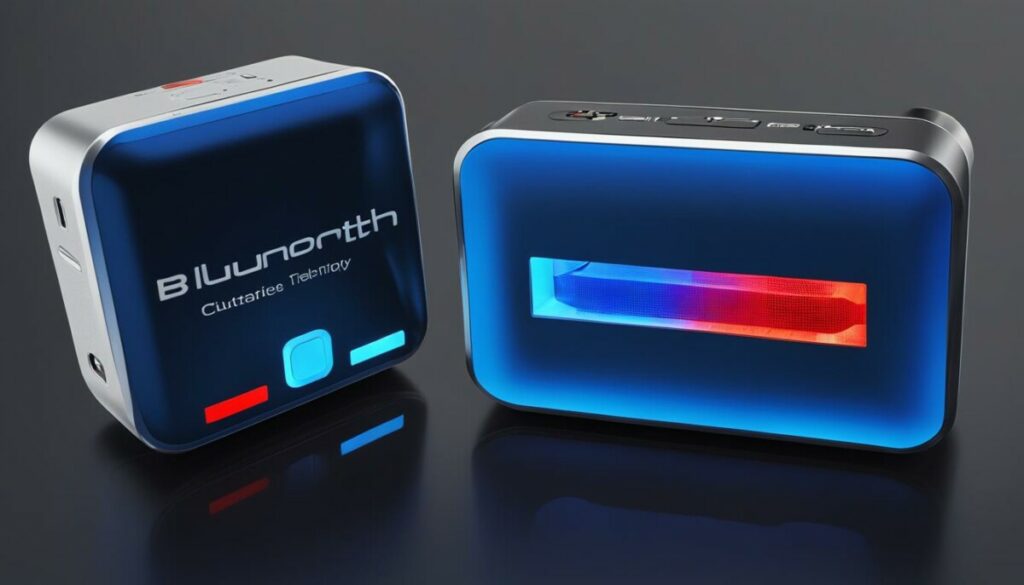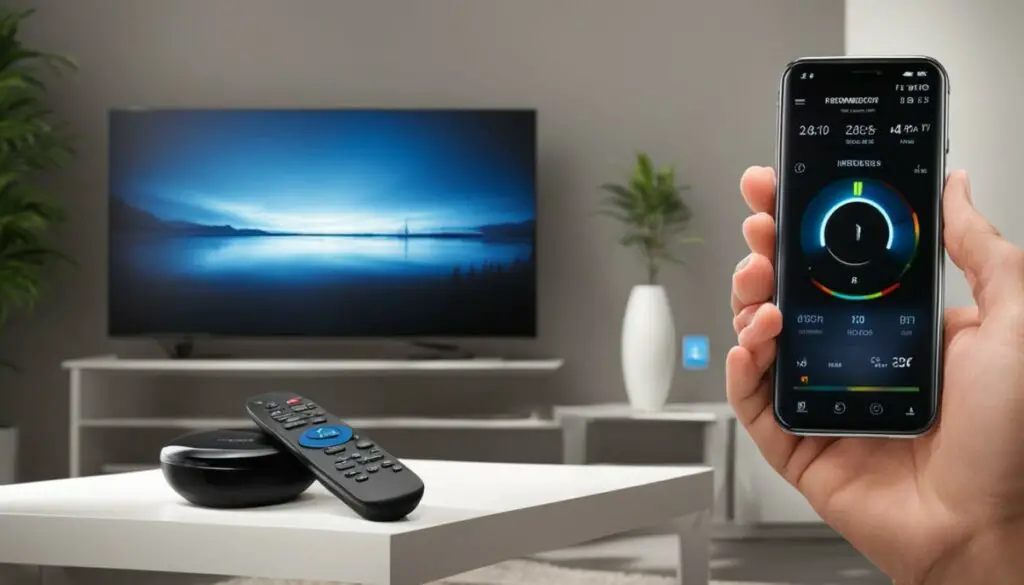Last Updated on 4 months by Francis
Remote controls have come a long way since their traditional infrared technology days. With the advancements in wireless technology, infrared remotes are being replaced by the more advanced Bluetooth technology. In this article, we will explore the shift from infrared to Bluetooth in remote controls and discuss the current state of these technologies.
Contents
Key Takeaways:
- Infrared remotes use infrared light to transmit data, while Bluetooth remotes use radio waves.
- Bluetooth remotes offer a longer transmission range and allow for multiple connections, while infrared remotes require a line of sight.
- Infrared has distance limits, while Bluetooth operates on a 2.4 GHz band.
- Bluetooth technology has lower energy consumption and offers a low energy mode.
- Bluetooth allows for multiple device connections, while infrared typically has a one-to-one connection.
- Infrared is commonly used in TV remotes and heat-sensing devices, while Bluetooth is used in various everyday devices such as smartphones and earbuds.
Bluetooth vs. Infrared: Key Differences

When it comes to wireless data transfer, Bluetooth and infrared are the two primary technologies in use. While both technologies serve the same purpose, they differ significantly in their transmission method, range, and connectivity capabilities.
Transmission Method: Bluetooth utilizes radio waves for data transmission, whereas infrared technology relies on infrared light. Bluetooth’s utilization of radio waves allows for a more versatile and robust transmission process.
Transmission Range: Bluetooth offers a longer transmission range compared to infrared. With Bluetooth, devices can be connected even if they are not within a direct line of sight. On the other hand, infrared requires a clear line of sight between the transmitting and receiving devices, making it limited by obstructions such as walls.
Multiple Connections: Bluetooth allows for multiple device connections, enabling users to connect various devices simultaneously. In contrast, infrared technology typically only allows for a one-to-one connection, meaning one remote control can connect to only one device at a time.
Developer Oversight: Bluetooth is overseen by the Bluetooth Special Interest Group, a consortium of major technology companies, ensuring ongoing development, interoperability, and compatibility. Infrared technology is managed by the Infrared Data Association.
To illustrate the key differences more comprehensively, refer to the table below:
| Bluetooth | Infrared | |
|---|---|---|
| Transmission Method | Uses radio waves | Uses infrared light |
| Transmission Range | Longer range, not limited by line of sight | Requires a clear line of sight, limited by walls interference |
| Multiple Connections | Allows for multiple device connections | Typically supports one-to-one connection |
| Developer Oversight | Bluetooth Special Interest Group | Infrared Data Association |
Overall, Bluetooth’s utilization of radio waves, longer transmission range, and ability to support multiple connections make it a more versatile and widely adopted technology than infrared. However, infrared technology still has its applications, particularly where a direct line of sight is readily available.
With a better understanding of the key differences between Bluetooth and infrared, we can delve into how each technology works and explore their respective applications.
Infrared Transmission: How Does it Work?

Infrared transmission is a method of wirelessly transmitting data between devices using infrared light. This technology relies on infrared sensors that detect the pulses of infrared light and interpret them as data. The data is transmitted using the infrared data protocol, which defines the format and structure of the information being transmitted.
When data is transmitted through infrared, it is important to consider the distance limits of this technology. Infrared signals have a limited range and can be obstructed by physical barriers like walls. Additionally, the wavelength of infrared light can be affected by external factors, which may impact the quality and reliability of the signal reception.
To achieve the same effect as infrared sources, such as remote controls, in certain situations, infrared sources can be replaced with candles. Candles emit a similar wavelength of light as infrared sources, allowing them to be detected by infrared sensors and transmit data wirelessly.
Advantages of Infrared Transmission
- Requires less power compared to other wireless transmission technologies
- Used in various applications, including remote controls, security systems, and communication devices
- Relatively low cost and widely available
Disadvantages of Infrared Transmission
- Limited distance range
- Line-of-sight requirement for effective communication
- Potential for interference from other sources of infrared light
Infrared transmission is a reliable and widely used technology for short-range wireless communication. While it does have its limitations, it offers a cost-effective solution for various applications.
| Infrared Transmission | Advantages | Disadvantages |
|---|---|---|
| Low power consumption | Reliable and widely available | Limited distance range |
| Used in various applications | Cost-effective | Line-of-sight requirement |
| Potential for interference |
Table: Advantages and disadvantages of infrared transmission.
Overall, infrared transmission plays a significant role in enabling wireless communication in a range of devices and applications. While it may have certain limitations, it remains a valuable technology for short-range data transfer.
Bluetooth: How Does It Work?

Bluetooth is a wireless technology that uses radio waves to enable data transmission between devices. Unlike infrared, which utilizes infrared light, Bluetooth operates on radio wave frequencies, specifically in the 2.4 GHz band, similar to Wi-Fi signals.
One key characteristic of Bluetooth is that its waves are weaker compared to other transmission types. While this may seem like a drawback, it actually results in lower energy consumption, making Bluetooth a suitable choice for battery-powered devices.
In addition, Bluetooth offers a low energy mode, known as Bluetooth Low Energy (BLE), which further reduces energy consumption. This mode is particularly beneficial for devices that require long battery life, such as fitness trackers and smartwatches.
However, it’s important to note that Bluetooth connections are limited to relatively short distances due to the weaker waves. This range restriction ensures that Bluetooth signals do not interfere with neighboring devices or cause congestion in the crowded 2.4 GHz band.
To summarize, Bluetooth utilizes radio waves in the 2.4 GHz band to transmit data wirelessly between devices. Its weaker waves result in lower energy consumption, especially in Bluetooth Low Energy mode. While it may have limitations in terms of range, Bluetooth remains a popular wireless technology for various applications.
Bluetooth utilizes radio waves in the 2.4 GHz band to wirelessly transmit data between devices. Its lower energy consumption and compatibility with Bluetooth Low Energy mode make it ideal for battery-powered devices.
Line of Sight and Device Position

One of the key differences between Bluetooth and infrared technology lies in the way they interact with devices. While infrared technology relies on a line of sight, Bluetooth offers more flexibility in terms of device position.
Infrared Technology and Line of Sight:
With infrared technology, a line of sight between the remote control and the device being controlled is necessary for proper functionality. The infrared sensor requires a clear path to transmit and receive signals. Any obstruction, such as a wall or object, can interfere with the line of sight and disrupt the transmission.
Bluetooth and Device Position:
On the other hand, Bluetooth technology does not depend on a direct line of sight. Bluetooth sensors can establish connections from any position around the host device, allowing for more flexibility in device placement. Whether the device is in front, behind, or even in a different room, Bluetooth can still establish a connection as long as it is within the specified range.
To illustrate the difference visually, consider the following table:
| Factor | Infrared Technology | Bluetooth Technology |
|---|---|---|
| Line of Sight Requirement | Yes | No |
| Device Position | Restrictions on placement | More flexible |
As shown in the table, infrared technology requires a line of sight and has restrictions on device placement. In contrast, Bluetooth technology enables greater flexibility in device positioning, making it more versatile for various use cases.
Energy Consumption

When it comes to energy consumption, both Bluetooth and infrared technologies have relatively low power requirements, making them suitable for battery-powered devices. However, Bluetooth has seen significant advancements in energy efficiency.
One notable development is the introduction of Bluetooth Low Energy mode (BLE), which further reduces energy consumption. BLE is designed for devices that require low-power connectivity, such as fitness trackers, smartwatches, and IoT devices. By optimizing power usage, Bluetooth Low Energy mode enables these devices to operate for extended periods without the need for frequent battery replacements.
It’s important to note that not all devices are compatible with Bluetooth Low Energy. Compatibility of BLE varies between devices, and certain devices may still use Classic Bluetooth, which has slightly higher energy consumption compared to BLE-enabled devices.
Overall, the decision to utilize Bluetooth or infrared technology depends on the specific requirements of the device and the desired level of energy efficiency.
| Technology | Energy Consumption |
|---|---|
| Bluetooth | Relatively low energy consumption |
| Bluetooth Low Energy mode (BLE) | Further reduces energy consumption |
| Infrared | Low energy consumption |
| Classic Bluetooth devices | Slightly higher energy consumption compared to BLE-enabled devices |
Number of Devices Connected
Infrared connections typically have a one-to-one connection, meaning one remote control can only connect to one device. This is because infrared technology relies on direct line of sight between the remote control and the device. In contrast, Bluetooth technology allows for multiple device connections, making it more versatile.
Bluetooth achieves multiple connections through a technique called frequency hopping. This process involves the device changing its frequency every few microseconds, allowing it to connect to multiple devices simultaneously. This makes Bluetooth a popular choice for devices such as smartphones, tablets, and laptops that often need to connect to multiple peripherals.
While multi-connection infrared devices do exist, they are relatively rare compared to Bluetooth. Bluetooth’s ability to handle multiple connections simultaneously has made it the go-to technology for users who need to connect and control multiple devices efficiently.
| Technology | Number of Devices Connected |
|---|---|
| Infrared | One remote control to one device |
| Bluetooth | Multiple devices simultaneously |
Practical Applications

Infrared technology and Bluetooth technology have found practical applications in various devices, offering convenience and enhanced functionalities to users.
Infrared Technology
One of the most common applications of infrared technology is in TV remotes. Infrared signals are used to transmit commands from the remote control to the TV, allowing users to switch channels, adjust the volume, and control other functions wirelessly.
In addition to TV remotes, infrared technology also plays a crucial role in heat-sensing devices such as thermal and night vision cameras. These devices use infrared sensors to detect the heat emitted by objects and create visual representations of the temperature variations. This technology is widely used in surveillance, military, and scientific applications.
Bluetooth Technology
Bluetooth technology has become an integral part of modern wireless connectivity. Its practical applications extend beyond just remote controls.
Smartphones, for example, utilize Bluetooth technology for various purposes. It enables users to connect their smartphones to wireless earbuds, headsets, or speakers, allowing them to enjoy music or make hands-free calls without the hassle of wires.
Game controllers also make use of Bluetooth to provide a seamless gaming experience. Bluetooth-enabled controllers can connect wirelessly to gaming consoles or smartphones, enabling users to play games from a distance and enjoy unrestricted movement.
Overall, Bluetooth technology has revolutionized the way we connect and interact with our devices, offering a wireless and convenient experience.
How TV Remotes Work – Infrared vs. Bluetooth

TV remote controls play a crucial role in our daily lives, allowing us to effortlessly control our TVs from a distance. But have you ever wondered how these remotes actually work? In this section, we’ll explore the two primary technologies used in TV remotes – infrared and Bluetooth – and discover their unique mechanisms of message transmission.
The Infrared Advantage
Infrared remotes utilize the power of LED (Light-Emitting Diode) lights to transmit signals to the TV. These LED lights emit infrared light, which falls within the infrared light spectrum and is invisible to the human eye.
When you press a button on your infrared remote, the LED light emits a specific sequence of binary code – a series of zeros and ones – that represents the command or message. This modulated infrared light carries the instruction and its corresponding binary code.
The TV receiver has an infrared sensor that detects the incoming infrared light pulses and interprets the binary code to understand the desired action. This allows the TV to respond accordingly, whether it’s changing the channel, adjusting the volume, or navigating through on-screen menus.
The Versatility of Bluetooth
Bluetooth, on the other hand, follows a different approach for remote control functionality. Instead of using infrared light, Bluetooth remotes rely on radio frequency (RF) technology to transmit signals.
Bluetooth utilizes the 2.4 GHz radio wave frequency band to establish a connection between the remote control and the TV. Unlike infrared, Bluetooth signals are not obstructed by walls or other objects, making it possible to control the TV from different positions without direct line of sight.
When you press a button on a Bluetooth remote, the remote sends a command signal via radio frequencies, carrying the necessary instructions. The TV has a Bluetooth sensor that receives and decodes the signal, allowing it to execute the desired action.
Overcoming Radio Frequency Interference
While Bluetooth remotes offer greater flexibility, they are susceptible to radio frequency interference. Other devices operating in the same RF frequency range, such as Wi-Fi routers, cordless phones, or even other Bluetooth devices, can cause interference and disrupt the signal transmission.
To mitigate this issue, Bluetooth devices employ frequency hopping, rapidly changing the frequency they use for transmission. This hopping mechanism helps minimize the impact of interference by constantly switching to different channels within the 2.4 GHz band, ensuring a reliable connection between the remote control and the TV.
Comparing Infrared and Bluetooth in TV Remotes
| Infrared Remotes | Bluetooth Remotes | |
|---|---|---|
| Message Transmission | Binary code sequences emitted through infrared light. | Command signals transmitted via radio frequencies. |
| Range | Requires line of sight; limited by distance and walls interference. | Works without line of sight; allows controlling from different positions. |
| Interference | Not affected by radio frequency interference. | Potential for interference from other RF devices. |
As seen in the comparison table above, both infrared and Bluetooth remotes have their distinct advantages and limitations. Infrared offers precise message transmission using binary code sequences, while Bluetooth provides greater flexibility and freedom of movement. Understanding these technologies helps us appreciate the innovation behind TV remote controls.
The Future of Remote Controls
Remote controls have come a long way thanks to advancements in technology. While infrared remotes are still widely used, more and more devices are adopting Bluetooth technology for seamless wireless connectivity. In addition to Bluetooth, voice control is emerging as a popular means of operating devices, revolutionizing the landscape of remote controls.
Bluetooth Technology: The Wireless Revolution
The rise of Bluetooth technology has paved the way for a new era of remote controls. Bluetooth offers several benefits over traditional infrared, including a wider range of compatibility and functionality. With Bluetooth, remote controls can connect to a variety of devices such as smartphones, smart TVs, and even home automation systems.
Voice Control: Hands-Free Convenience
Voice control is gaining momentum as a convenient way to operate remote controls. With the help of voice assistants like Amazon’s Alexa or Google Assistant, users can simply give vocal commands to control their devices. This technology eliminates the need to search for remote controls or navigate complex menus, making the user experience more intuitive and hands-free.
| Advantages of Bluetooth Remote Controls | Advantages of Voice Control |
|---|---|
| Wide compatibility with various devices | Convenience and ease of use |
| Ability to connect multiple devices simultaneously | Hands-free operation |
| Improved range for uninterrupted control | Effortless navigation of menus |
| Reduced interference from obstacles | Enhanced accessibility for individuals with disabilities |
With the combination of Bluetooth technology and voice control, the future of remote controls is set to become more seamless and intuitive than ever before.
Conclusion
In conclusion, the evolution of remote controls from traditional infrared technology to the more advanced Bluetooth technology has revolutionized the way we interact with our devices. While infrared remote controls are still widely used and offer reliable functionality, Bluetooth technology has brought numerous advantages to the table.
Bluetooth remote controls offer greater flexibility, allowing users to control their devices from various positions without the need for a direct line of sight. Additionally, Bluetooth provides a longer transmission range, enabling users to control their devices from a greater distance. This is especially beneficial in larger living spaces where infrared signals may struggle to reach.
Moreover, Bluetooth remote controls offer multi-connection capabilities, allowing users to connect multiple devices simultaneously. This is particularly convenient for households with multiple audiovisual devices, eliminating the need for multiple remotes.
As modern technology continues to advance, it is likely that remote controls will further integrate Bluetooth and other wireless technologies. The convenience, functionality, and compatibility offered by Bluetooth make it an ideal choice for remote control applications, paving the way for a future where wireless connectivity and seamless device control become the norm.
FAQ
How does Bluetooth technology differ from infrared technology in remote controls?
Bluetooth uses radio waves for transmission, allowing for longer range and multiple connections. Infrared requires a line of sight and is limited by walls interference.
How does infrared transmission work in remote controls?
Infrared technology uses infrared light to transmit data from one device to another. Infrared sensors detect the pulses of infrared light, and the data is transmitted using the infrared data protocol.
How does Bluetooth technology work in remote controls?
Bluetooth uses radio waves to transmit data. It operates on 2.4 GHz radio wave frequencies and uses a 2.4 GHz band similar to Wi-Fi signals.
Do infrared or Bluetooth remotes have better energy consumption?
Both infrared and Bluetooth technology have relatively low energy consumption. Bluetooth offers advancements such as Bluetooth Low Energy mode, but compatibility varies between devices.
Can multiple devices be connected to a remote control?
Infrared connections typically have a one-to-one connection, while Bluetooth allows for multiple device connections through frequency hopping.
What are some practical applications of infrared and Bluetooth technology?
Infrared technology is commonly used in TV remotes and heat-sensing devices. Bluetooth technology is used in various everyday devices such as smartphones, earbuds, and game controllers.
How do TV remotes work using infrared or Bluetooth?
Infrared remotes use an LED light to emit infrared light in a specific sequence of binary code to send messages. Bluetooth remotes use radio waves to transmit signals.
What does the future hold for remote controls?
As technology continues to evolve, remote controls are likely to see further integration of Bluetooth and other wireless technologies, as well as the rise of voice control.








